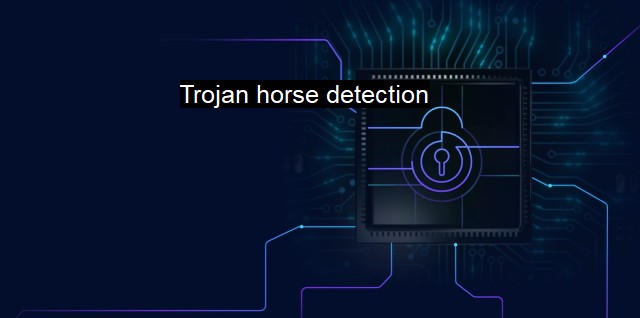What is Trojan horse detection?
Trojan Horse Detection: Safeguarding Your Cybersecurity with Antivirus Software
Formidable challenges are being posed to cybersecurity because of an increasing number of threats that leverage the internet infrastructure to deliver malware and cyberattacks. One such malicious attack that needs special focus is the infamous Trojan horse misuse. The term "Trojan horse" was borrowed from ancient Greek mythology. Just as in the ancient tale, where invading soldiers were stealthily transported into the city of Troy using a colossal wooden horse disguised as a benevolent gift, a Trojan horse in the context of digital security is a harmful piece of software that misrepresents itself to appear legitimate.To combat such threats necessitates the need for advanced Trojan horse detection mechanisms, which consists of tools/techniques and algorithms used in identifying, tracking, and neutralizing Trojan horse threats. As they invisibly infiltrate the targeted system, Trojans bypass security systems to steal sensitive information or launch attacks. Trojan horse detection forms an integral part of cybersecurity strategy and antivirus deployments because a Trojan horse, or simply Trojan, can seriously compromise the security and integrity of a digital system.
In broader terms, Trojan horse detection can be defined as a process employed by cybersecurity experts and antivirus software to find and delete Trojans from a given system. This is achieved through multiple techniques.
On a fundamental level, antivirus systems scan computer files for known viruses and Trojan horses. The malware, including Trojan horses, leave a unique signature or pattern in computer systems. These signatures are stored in antivirus databases. When the antivirus software scans a file, it matches the patterns inside the file with those in its database. If it finds a matching pattern, the antivirus treats the file as infected and acts accordingly, isolating or terminating the Trojan as per the software's protocols.
In many cases though, this classic method proves insufficient owing to the evolving sophistication of Trojan horses. This is where advanced Trojan detection algorithms come into the picture. These methods typically work based on detecting anomalous behavior in a system typically indicative of a Trojan horse attack. Techniques such as heuristic analysis, that identifies new or modified forms of malware even when they aren't present in existing databases, or sandbox technology, that isolates and monitors the behavior of new applications in real-time in a secure environment, are being more commonly used now.
Artificial Intelligence and machine learning methods are now also being harnessed for Trojan horse detection. They enable the creation of learning models that, based on existing knowledge of Trojan malware, become progressively better at detecting varieties of Trojans. Machine learning provides these models the capability to adapt to changing modalities of the Trojan malware.
Trojan horse detection isn't fool-proof yet. Cybercriminals are becoming craftier, embedding Trojans in encrypted communications or in advanced persistent threats. These are sophisticated strategies that maintain long periods of dormancy, only to launch unexpected attacks at opportune moments.
Trojan horse detection isn't just one method; it's an investigative suite of diversified methods because the Trojan horse is a continually evolving threat. Practicing good internet hygiene, like keeping software updated, performing routine scans, and avoiding spam emails, are the frontline defense. for thorough protection against increasingly complex Trojan horses, advanced cybersecurity strategies focused on sophisticated Trojan horse detection are required. Strategies that incorporate cutting-edge innovations like machine learning and artificial intelligence are equipping organizations with better tools to contest the Trojan horse arms race. It's an ongoing battle - digital security professionals continue to refine the tools for Trojan horse detection with a new degree of technological sophistication.

Trojan horse detection FAQs
What is a Trojan horse and how can it affect my computer?
A Trojan horse is a type of malware that disguises itself as legitimate software to gain access to a computer system. Once inside, it can perform various malicious activities such as stealing sensitive data, modifying or deleting files, and installing additional malware.How can I detect a Trojan horse on my computer?
You can detect a Trojan horse by using antivirus software that scans your computer for potential threats. It's also important to avoid downloading files or clicking on links from unfamiliar sources, as these are common ways for Trojans to infect a system.What are the signs that my computer might be infected with a Trojan horse?
Some common signs of a Trojan horse infection include slow computer performance, unusual pop-up ads, changes to your desktop or web browser settings, and the appearance of new icons or files on your desktop. If you suspect that your computer may be infected, it's important to run a full antivirus scan to identify and remove any threats.Can a Trojan horse be removed from my computer, or do I need to replace my entire system?
Most Trojan horses can be removed from a computer using antivirus software or other security tools. In some cases, however, the malware may have caused irreversible damage to the system, in which case it may be necessary to replace certain components or even the entire system. It's always best to take prompt action to address any suspected malware infections, as the longer you wait, the greater the risk of data loss or other serious consequences.| | A | | | B | | | C | | | D | | | E | | | F | | | G | | | H | | | I | | | J | | | K | | | L | | | M | |
| | N | | | O | | | P | | | Q | | | R | | | S | | | T | | | U | | | V | | | W | | | X | | | Y | | | Z | |
| | 1 | | | 2 | | | 3 | | | 4 | | | 7 | | | 8 | | |||||||